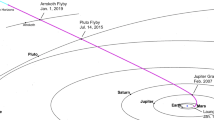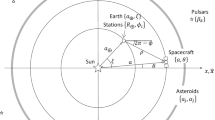Abstract
This paper describes the guidance and navigation technique used by Hayabusa2 for the asteroid rendezvous operation to reach Ryugu. The operation results, including the achieved guidance and navigation performance, are also summarized. Multiple assessment and navigation teams worked closely to provide reliable navigation solutions with a short solution delivery cycle. Although the uncertainty of the Ryugu’s ephemeris was considerable before Hayabusa2’s arrival, a combination of radiometric-optical hybrid navigation and a stochastic-constrained optimum guidance method was able to achieve an accuracy of less than 100 m and 1 cm/s, and the arrival was precisely timed.
Similar content being viewed by others
Change history
11 February 2022
A Correction to this paper has been published: https://doi.org/10.1007/s42064-022-0136-2
References
Tsuda, Y., Yoshikawa, M., Abe, M., Minamino, H., Nakazawa, S. System design of the Hayabusa 2—Asteroid sample return mission to 1999 JU3. Acta Astronautica, 2013, 91: 356–362.
Tsuda, Y., Saiki, T., Terui, F., Nakazawa, S., Yoshikawa, M., Watanabe, S., Hayabusa2 Project Team. Hayabusa2 mission status: Landing, roving and cratering on asteroid Ryugu. Acta Astronautica, 2020, 171: 42–54.
Tsuda, Y., Takeuchi, H., Ogawa, N., Ono, G., Kikuchi, S., Oki, Y., Yamaguchi, T., Ishiguro, M., Kuroda, O., Utakawa, S., Okumura, S. Guidance and navigation result of Hayabusa2 asteroid rendezvous operation. In: Proceedings of the 32nd International Symposium on Space Technology and Science, 2019: 2019-d-074.
Tsuda, Y., Saiki, T., Ogawa, N., Morimoto, M. Trajectory Design for Japanese New Asteroid Sample Return Mission Hayabusa-2. In: Proceedings of the 23rd International Symposium on Space Flight Dynamics, 2012: IMD-1-1.
Kameda, S., Suzuki, H., Takamatsu, T., Cho, Y., Yasuda, T., Yamada, M., Sawada, H., Honda, R., Morota, T., Honda, C. et al. Preflight calibration test results for optical navigation camera telescope (ONCT) onboard the Hayabusa2 spacecraft. Space Science Reviews, 2017, 208(1–4): 17–31.
Takeuchi, H., Yoshikawa, K., Takei, Y., Oki, Y., Kikuchi, S., Ikeda, H., Soldini, S., Ogawa, N., Mimasu, Y., Ono, G., et al. The deepspace multi-object orbit determination system and its application to Hayabusa2’s asteroid proximity operations. Astrodynamics, 2020, https://doi.org/10.1007/s42064-020-0084-7.
Nakatani, I., Kubota, T., Isaka, T. Navigation for small body rendezvous by visual active sensing. In: Proceedings of International Symposium on Space Dynamics, 1995: 853–858.
Van Dokkum, P. G. Cosmic-ray rejection by laplacian edge detection. Publications of the Astronomical Society of the Pacific, 2001, 113(789): 1420–1427.
Lang, D., Hogg, D. W., Mierle, K., Blanton, M., Roweis, S. Astrometry.net: blind astrometric calibration of arbitrary astronomical images. The Astronomical Journal, 2010, 139(5): 1782–1800.
Bertin, E., Arnouts, S. SExtractor: Software for source extraction. Astronomy and Astrophysics Supplement Series, 1996, 117(2): 393–404.
Watanabe, S., Hirabayashi, M., Hirata, N., Hirata, N., Noguchi, R., Shimaki, Y., Ikeda, H., Tatsumi, E., Yoshikawa, M., Kiknchi, S. et al. Hayabusa2 arrives at the carbonaceous asteroid 162173 Ryugu—A spinning top-shaped rubble pile. Science, 2019, 364(6437): 268–272.
Acknowledgements
The authors are grateful to the entire Hayabusa2 operation team for achieving this goal and supplying the operation product used in this analysis. JSPS KAKENHI Grant No. 18H01628 also supported this work.
Author information
Authors and Affiliations
Consortia
Corresponding author
Additional information
Yuichi Tsuda received his Ph.D. degree in aeronautics and astronautics from the University of Tokyo in 2003 and joined JAXA the same year as a research associate. Dr. Tsuda was a visiting scholar at the Department of Aerospace Engineering, University of Michigan and Department of Aerospace Engineering Sciences, the University of Colorado Boulder in 2008–2009. He was a deputy lead of the IKAROS project, the world’s first interplanetary solar sail mission. He is currently a professor at Institute of Space and Astronautical Science (ISAS)/Japan Aerospace Exploration Agency (JAXA) and is also the project manager of Hayabusa2, an asteroid sample-return mission. His research interests are astrodynamics, spacecraft system, and deep space exploration.
Hiroshi Takeuchi received his Ph.D. degree in physics and applied physics from Waseda University in 2000. In 2006 he began working for ISAS/JAXA as a member of the deep space orbit determination group. Dr. Takeuchi was a visiting researcher at the NASA Jet Propulsion Laboratory in 2012–2013. He is currently an associate professor at ISAS/JAXA and is also the lead for the orbit determination of Hayabusa2. His current research interest lies in developing the deep space multi-objects orbit determination system.
Naoko Ogawa received her B.E., M.E., and Ph.D. degrees in mathematical engineering and information physics in 2000, 2002 and 2005, respectively, from the University of Tokyo, Japan. From 2004 to 2008, she was a research fellow at the Japan Society for the Promotion of Science. Since 2008 Dr. Ogawa has been a research engineer at ISAS, JAXA. Her current research interests include astrodynamics, mission design, robotics, spacecraft systems and operation.
Go Ono is a researcher at JAXA. He graduated with a master’s degree in engineering from the University of Bath in 2011, and with a Ph.D. degree in aerospace engineering from the University of Tokyo in 2014. Dr. Ono joined JAXA in 2015 and has been working on the guidance, navigation, and control systems for JAXA’s deep-space missions such as Hayabusa2 and MMX. His current research interests are astrodynamics and deep space exploration.
Shota Kikuchi received his Ph.D. degree in aeronautics and astronautics from the University of Tokyo in 2018. From 2015 to 2017, he served as a visiting scholar at Purdue University and NASA Jet Propulsion Laboratory. He is currently a postdoctoral research associate at JAXA and is engaged in the Hayabusa2 asteroid sample return mission as a system engineer. His primary research interests lie in the field of astrodynamics, particularly in the dynamics around small bodies.
Yusuke Oki is a researcher at JAXA. He graduated with a master’s degree in astronautics from the University of Tokyo in 2016 and with a Ph.D. degree in astronautics from the University of Tokyo in 2019. Dr. Oki joined JAXA in 2019 and has been working on the system and orbit design of spacecraft. His current research interests lie in the areas of astrodynamics, concurrent design, and deep space exploration.
Masateru Ishiguro completed his Ph.D. degree in Earth and planetary science from Kobe University in 2000. Post his doctorate, he participated in the MUSESC (renamed Hayabusa after launch) in 2001 as a researcher and worked at ISAS until 2006. Later, Dr. Ishiguro joined the Astronomy Program at Seoul National University (SNU) as a postdoctoral fellow (later a research professor) in 2006 and National Astronomical Observatory of Japan as a research associate in 2008. He has taken up a faculty position at SNU since 2009. Dr. Ishiguro has also worked as a visiting astronomer at the University of Hawaii in 2004–2005, University of California, Los Angeles in 2013–2014, and Paris Observatory in 2014. Currently, he is a full professor at SNU and leads the solar system research group. His research interests include the formation and evolution of the solar system through observations.
Daisuke Kuroda received his Ph.D. degree in science from the Graduate University for Advanced Studies, Japan, in 2006. He is currently a program-specific assistant professor at Okayama Observatory of Kyoto University. His research interests include physical characteristics of small Solar System bodies, software engineering for astronomy, and development of robotic telescope.
Seitaro Urakawa received his Ph.D. degree in astronomy and planetary science from Kobe University in 2005 and joined the Japan Spaceguard Association in 2006 as a researcher after six months of research activity as a research fellow at the Japan Society for the Promotion of Science. His research fields include observational study for near-Earth asteroids, space debris, and exoplanets.
Shin-ichiro Okumura received his Ph.D. degree in astronomy from the University of Tokyo in 1997. He is currently the director of the Space Guard Research Center of Japan Spaceguard Association. Dr. Okumura has worked on the observation of asteroids and space debris at the Bisei Spaceguard Center since 2005. Before working at the Bisei Spaceguard Center, he was engaged in remote sensing at JAXA, after studying infrared astronomy and data archival system at the National Astronomical Observatory of Japan. His research interests include optical observational techniques for moving objects, massive star-forming regions, and the evolution of high mass stars.
Rights and permissions
About this article
Cite this article
Tsuda, Y., Takeuchi, H., Ogawa, N. et al. Rendezvous to asteroid with highly uncertain ephemeris: Hayabusa2’s Ryugu-approach operation result. Astrodyn 4, 137–147 (2020). https://doi.org/10.1007/s42064-020-0074-9
Received:
Accepted:
Published:
Issue Date:
DOI: https://doi.org/10.1007/s42064-020-0074-9




